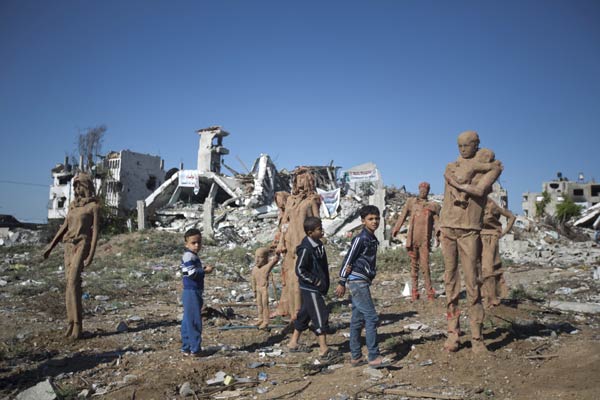Palestinian artist captures Gaza's pain in clay sculptures
|
Palestinian artist Iyyad Sabbah's clay statues stand amid the rubble of buildings destroyed during the 50 days of conflict between Israel and Hamas last summer. The sculptures have been installed in the Shejaiya neighborhood of Gaza City. Mahmud Hams / Agence France-Presse |
Amid the mountains of rubble littering Gaza after a deadly summer war, clay outlines emerge of men, women and children with a story to tell about fear, flight and destruction.
Through his sculptures, which are made of fiberglass covered with clay, Iyyad Sabbah relates the pain of those who lived through the latest conflict with Israel, in which nearly 2,200 Palestinians were killed, mostly civilians.
Some - those closest to the ruins of homes flattened by bombs in Gaza City's eastern Shejaiya district - are splashed with blood-red paint.
The neighborhood, on the border with Israel, was at the front line when ground troops went in. It was largely reduced to a wasteland in a war launched to halt cross-border rocket fire into Israel.
Sabbah, a professor of art at Gaza's Al-Aqsa University, chose to locate his installation in Shejaiya, attracting many passers-by.
"These statues recall the war, when we fled - men, women and children - some in just their underwear," Mohammed al-Latif, 20, reflected. He escaped his home shortly before it was flattened in an Israeli drone strike.
"These statues are a new form of art that gives form to the suffering of Gazans," said the artist, who was delighted at the warm reception local people have given his figures.
Wary of hostility from conservative Muslims opposed to his depiction of the human form, he was happy to see dozens of adults and children crowding round for a closer look at his work.
Among the sculptures is a figure of a barefoot woman, her features barely discernible, carrying a naked child. Next to her is an old man leaning on a stick, a disheveled little boy in his arms.
Not everybody gets it.
"It's very nice but why set up these statues here, in the place where the Jews bombed us?" asked Salah al-Khissi on his way to school.
"With this project I am speaking about people's flight from their homes during the war", fought in July and August, Sabbah explained. "I'm trying to shine a spotlight on the crimes the Israelis committed here.
"For Gazans this form of art is unknown and intriguing," he said, expressing hope that the installation might also have a therapeutic effect.
"We must treat the human aspect, take care of Palestinians who have been psychologically destroyed and whose society has collapsed."
To drive home the idea of fragility and collapse, Sabbah deconstructs his subjects. Seen from the front, they look almost alive.
But from behind, you can a see their hollow frames and the cracked clay - metaphors, he said, for the "disintegration of society and the flagrant attacks on Palestinian rights".
With these statues, which put a face on suffering, he also hopes to "send a message to Israel that it has destroyed the humanity of Gazans by destroying their homes and their infrastructure".
For Mohammed Muslim, also a professor of art at the university, Sabbah's works are a reminder of the war but at the same time works that "express a dynamic".
"Families have left and need help to return to a normal life," he said.
But two months after the war's end, practically no building material has entered Gaza because of Israel's ongoing blockade.
With more than 100,000 homes damaged in the 50-day conflict - affecting a third of Gaza's population of 1.8 million - a return to normalcy looks far off.



















